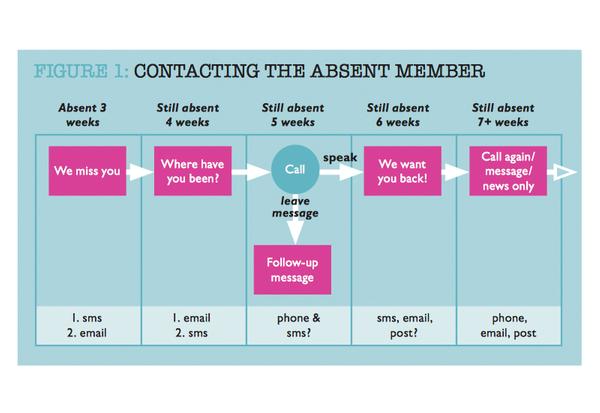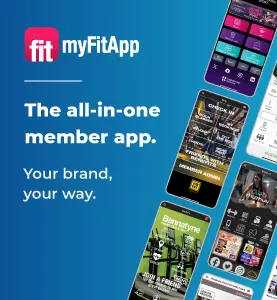Absent and ex-members are two under-used segments in many clubs’ databases. Not only can they provide critical business information on how you could adapt or improve retention, but these member groups can also be a great source of sales.
Fear is the main reason why these members are not contacted: club operators worry about awakening dormant members, and are concerned that they will receive negative feedback from people who have left. But sticking your head in the sand is a much riskier strategy; if all your dormant members cancelled tomorrow, your business would be in serious trouble, and if you don’t know why members are leaving, how can you expect to make people stick around?
In the same way that the member journey should not end after the first few weeks, you need to plan what happens when a member stops visiting, and after they leave.
Pay versus stay
Let’s start with measurement. Knowing your average membership length is a good place to start, but ‘length of pay’ is different from ‘length of stay’. Consider a member who stops paying in month 12; it’s no good contacting them in month 11 if they last visited in month seven. At GGFit, we often work with length of stay – ie first to last visit – as it’s a truer identifier of member engagement and allows you to affect retention more directly.
Another useful metric to understand is the average time from the last visit date to cancellation date – this gives you an idea of how long you have to try to re-engage a dormant member.
Who’s going to call?
When deciding how to contact absent members, you need to know what’s most effective, but also take into account what’s practical or possible with the resources you have at your club.
Phone conversations are most effective at getting members back, but you will often have to make a lot of phone calls to have a few conversations, and timing is key to success. Some clubs use customer service staff or even a call centre to make these calls, but instructors are best placed, since they have already had face-to-face member contact in the gym. Whether or not they are motivated to call absent members can depend on their own goals, rewards – or, to put it bluntly, job spec. If some of your instructors would prefer to do the cleaning than call absent members, perhaps it’s time to adjust their focus or change their job spec. Properly motivated instructors should be keen to get their members back into the club.
However, if you know that other staff will get the job done, they may prove to be the best route.
Send a message first
A great way to reduce the number of calls required is to text or email members before you call them. This will bring a few members back already, as well as making the calls easier – you can ask them if they received the message as an ice-breaker (see Figure 1 for an example of an absent member communication process).
Some clubs use text/email only for their absent member communication. This is better than nothing, but you can get a much better return rate if you check the reports from your retention communications to determine which members should be prioritised for follow-up calls.
Mixing up your communication channels also keeps the message fresh and means you can reach out to more of your members: you may not have all details for all members, and some may have opted out of certain forms of communication, so a postcard or letter can also be a good option to get in touch with absent members.
Meanwhile guest passes (with a value printed on them) can bring members back with their friends in tow, increasing your prospect list; friends who work out together are also more likely to stay.
If you must offer a PT session as an incentive, don’t say it’s free (anything that is free has little value). Instead, tell the member that the club will pay for a £50 PT session for them if they return.
Just by showing that you care about a member’s visits and fitness, you can extend their membership by another month. For the price of an email, text or postage stamp, it’s a no-brainer.
To get started today, take the 100 or so members who have recently become dormant, say from the last month or two. Don’t begin by contacting members who haven’t visited the club for over a year, as they truly are sleeping dogs. Build a list of members who visited four to eight weeks ago, but who have not visited in the last four weeks. Put a stake in the ground, resolve to get newly absent members back into the club, then repeat weekly.
Ex-members
It’s notoriously difficult to leave many clubs, but making it hard to cancel a membership does nothing to improve member retention. You might get another month’s membership from people, but they leave feeling totally disillusioned. Finding out the reason a member wants to leave and offering an alternative or a membership freeze can help, but by the time they want to stop paying, it’s usually too late. This is why you must contact them earlier, when you notice their visit rate dwindling.
If you want to report on reasons for leaving, it’s a good idea to give members a choice of options to explain why they leave – for example, health/ service/ money/ location/ results. You don’t need to make it easy to leave, but the process should be simple and straightforward, just like your joining process.
Leaver’s survey
Once they’ve gone, ex-members are largely overlooked. However, if you have good ex-member data, it’s worth regularly contacting them for research and re-sale. Even if you recorded why they left when they cancelled, consider sending a leaver’s survey a month later. This can tell you the real reason they left (rather than the excuse they gave), as well as giving you a chance to see what they’re up to now, or where they’ve gone. All this information can be used to trigger future contacts, as well as collecting feedback to improve the club.
Continue to contact ex-members regularly: a quarterly newsletter and/or survey to ex-members should be a regular communication from your database. The prime focus here is to stay in touch; if an ex-member completes the survey, they should get a voucher to re-visit or re-join. The actual answers to the survey are less important. That said, it’s good to use positive questions rather than reminding them why they left. Ask about current exercise goals and habits, perhaps use the Net Promoter question (how likely they are to recommend your club), and include an open question for comments and feedback.
You will get some interesting comments, possibly even some spiteful ones (these are ex-members after all), and occasionally some ‘unsubscribe’ requests. Focus on the positives: if there’s anything you can change, then do so; respond to positive comments; and track the vouchers or offers redeemed.
Face your fears
The complete member journey should run from beginning to end, and if possible beyond. To run a successful club, you need to face your fears and contact absent and ex-members.
When members stop attending your club, do something about it; some may go on to actually leave because of your actions, but you’ll get many more re-engaged and coming back.
And when some of your members do leave, don’t ignore them: learn from them, turn them back into prospects if you can, and try to get them back when the time is right.

























































